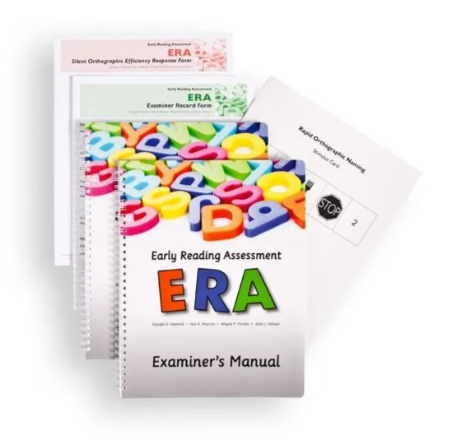(ERA) Early Reading Assessment
Ages: 4.0 through 7.11 years
Administration: Individual; 10-15 minutes
The ERA Complete Kit includes:
• Examiner’s Manual
• Picture Book
• Examiner/Record Forms(25)
• RON Stimulus Cards
• SOE Student Record Forms(25)
Donald D. Hammill / Nils A. Pearson / Wayne P. Hresko / John J. Hoover
The ERA is a screening test designed to identify young children who have reading problems.
Classroom teachers, special educators, speech pathologists, and school psychologists can easily
administer and score the ERA subtests.
Three core subtests measure print competence pertaining to the alphabet, word identification, and word comprehension using both silent and oral formats. The content of these subtests measures both early manifestations of reading and requisite skills that lead directly to reading. The supplemental oral language subtests measure important non-print correlates of reading.
Core Subtests and Composite Index:
• Written Word Vocabulary (WWV): measures print knowledge. In this subtest, the child is
shown a picture or letter that is accompanied by an array of five choices.
• Rapid Orthographic Naming (RON): measures letter-word identification and comprehension knowledge (i.e., oral word reading fluency)
• Silent Orthographic Efficiency (SOE): measures the speed with which children can match
letters and words (i.e., silent word reading fluency)
• Early Reading Index (ERI): The normative score that is formed by combining the results of
the core subtests is called the ERI and is a type of standard score.
• Written Word Vocabulary: measures print knowledge (i.e., silent word reading comprehension)
Supplemental Oral Language Subtests:
• Phonological Awareness (PA): measures the ability to discriminate among and manipulate
phonemes.
• Receptive Vocabulary (RV): measures understanding of common vocabulary.
The ERA yields age equivalents, percentile ranks, scaled scores, and a composite, the Early Reading Index. Subtest standard scores have a mean of 10 and a standard deviation of 3. The Index has a mean of 100 and a standard deviation of 15.



